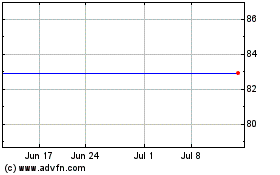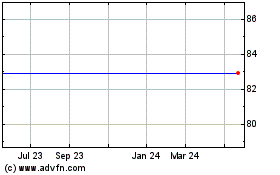Barrick Strikes Gold-Mines Deal -- WSJ
25 September 2018 - 5:02PM
Dow Jones News
Randgold Resources to be purchased for $6 billion, solidifying
industry leadership
By Scott Patterson and Jacquie McNish
This article is being republished as part of our daily
reproduction of WSJ.com articles that also appeared in the U.S.
print edition of The Wall Street Journal (September 25, 2018).
Barrick Gold Corp. agreed to buy Randgold Resources Ltd. for $6
billion in an all-share merger that will solidify Barrick as the
world's largest gold company by production, with a dominant
position in Africa.
Barrick shareholders will own 67% of the combined company, and
Randgold investors will own 33%, the companies said Monday. The
deal remains subject to shareholder approval.
Despite warnings ahead of Monday's market opening from some
analysts that Randgold's investors might balk at the no-premium
deal, its stock price closed up 6% in London. Barrick's stock rose
5.4% in New York.
The deal will pair two of the gold-mining industry's biggest
personalities: Barrick's John Thornton, a former Goldman Sachs
Group Inc. executive, and Randgold Chief Executive Mark Bristow,
renowned for taking motorcycle trips through Africa.
Both executives are also known for focusing on keeping costs in
line and reining in debt. Barrick reported an adjusted profit of
$876 million last year, compared with a loss of more than $10
billion in 2013. Randgold posted net income of $335 million in
2017, a 14% increase from the previous year.
Based on 2017 results, the enlarged group would have generated
revenue of $9.7 billion and adjusted earnings before interest,
taxes, depreciation and amortization of $4.7 billion, the companies
said.
The talks between the companies began in 2015, Mr. Bristow said
on a conference call Monday.
"Barrick and Randgold are cut from a single cloth," Mr. Thornton
said on the call. "Our two companies think and act in the same
way."
The initial investor support reflects confidence in Mr. Bristow,
who will be named chief executive of the combined entity early next
year when the deal is set to close. He has earned a loyal investor
following as a thrifty operator of Randgold's five African gold
mines who is hyperfocused on boosting shareholder gains. Widely
seen as one of the best managers of gold assets in the world, Mr.
Bristow is known for saying that he can profitably operate his
company's mines even if gold prices were to fall to $1,000 an
ounce, a promise few other mining companies could make.
Barrick, the world's largest gold producer, hasn't had a CEO
since 2014, and its president resigned last month. Mr. Thornton,
Barrick's executive chairman, has faced investor criticism for the
company's falling gold production and operating setbacks at some of
its mines. Mr. Thornton will continue to hold the title.
Barrick has struggled in recent years under Mr. Thornton's
leadership, and its stock has lagged behind competitors such as
Newmont Mining Corp., its closest rival by production. Barrick's
portfolio of gold mines has shrunk under Mr. Thornton, with about
one-third of the 30 mines the company operated when the executive
was appointed executive chairman of the gold-mining giant in
2014.
Barrick's gold production has also dwindled, falling more than
25% since 2013 to 5.3 million ounces last year. The acquisition of
Randgold, whose production is focused on Africa and which produced
1.3 million ounces in 2017, will help make up the loss.
The big bet on Africa comes at a time when Barrick needs help
navigating the challenges of working in the resource-rich
continent. Those struggles were highlighted last year after the
Toronto mining company's majority-owned African subsidiary Acacia
Mining PLC agreed to pay $300 million to the government of Tanzania
to resolve tax and revenue-sharing disputes over three gold mines.
Acacia's stock price in London has sunk nearly 30% since paying the
penalty.
The Acacia problems combined with Randgold's mines in
higher-risk countries such as the Democratic Republic of Congo
raised concerns from some analysts that Barrick could face
increased risk.
While Mr. Bristow's career has been focused on mining, Mr.
Thornton is a latecomer to the industry. He retired as president of
Goldman in 2003 after a 23-year career with the firm as a deal
maker and head of European and Asian expansion. He became an
adviser and teacher with the business school at Tsinghua
University, one of China's top schools.
Mr. Thornton's China connections attracted the attention of
Barrick's founder, the late Canadian mining tycoon Peter Munk, who
invited the banker in 2011 to be a member of the company's advisory
board. In 2012, Mr. Thornton was promoted to co-chairman of its
board of directors.
With gold prices swooning in 2013, Mr. Thornton sought to
negotiate a merger with Colorado's Newmont Mining. But the talks
fizzled, and Mr. Thornton, appointed executive chairman of Barrick,
focused on shrinking the assets of the debt-laden mining
behemoth.
Write to Scott Patterson at scott.patterson@wsj.com and Jacquie
McNish at Jacquie.McNish@wsj.com
(END) Dow Jones Newswires
September 25, 2018 02:47 ET (06:47 GMT)
Copyright (c) 2018 Dow Jones & Company, Inc.
Randgold Resources Limited ADS Each Represented BY One Ordinary Share (delisted) (NASDAQ:GOLD)
Historical Stock Chart
From Dec 2024 to Jan 2025

Randgold Resources Limited ADS Each Represented BY One Ordinary Share (delisted) (NASDAQ:GOLD)
Historical Stock Chart
From Jan 2024 to Jan 2025
